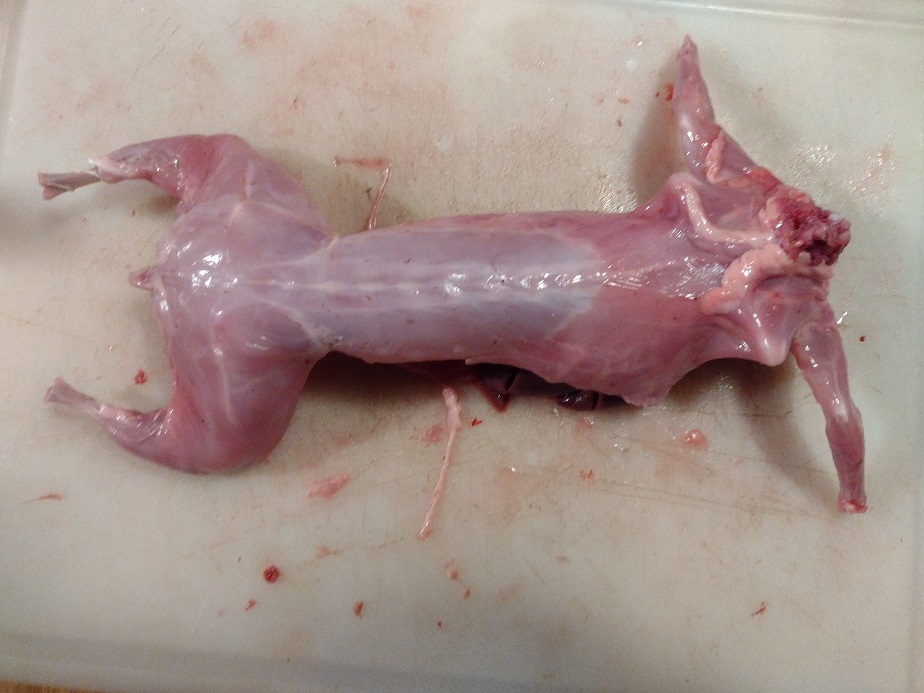Rabbits are the simplest animals we’ve raised for meat. Done right, it can be cheap and effective.
Meat rabbits cost between $4.62 and $6.75 each in feed costs when fed commercial rabbit feed. That’s $1.84-$2.70 a pound of meat for a rabbit reaching 5 pounds live weight at 12 weeks. If feeding wild fodder or high-quality hay, feed costs can be lowered dramatically. Many people raise rabbits for under $0.50 a pound.
Let’s break down the costs further, and go over different feeding and housing options.
Figuring the Cost of Raising Rabbits for Meat
There are a lot of variables, but There’s also a lot of more or less standard information in breeding and raising meat rabbits. First, let’s assume you are planning on raising a commercial-type rabbit. Other rabbits may do, and some very well, but for the dollars, I’m figuring based on a commercial breed.
The only non-commercial breed I have experience with is the Holland Lop, and that made a fine but smaller meat rabbit. Anyways, Comercial-breed rabbits have more or less the same base feed consumption and housing requirements.
Here are the basics. A good commercial-breed rabbit will grow to 5 pounds at 12 weeks old and will yield a 2-1/2 pound carcass. The average litter size is 8 bunnies, and they are weaned between 4 and 6 weeks. A female and her bunnies will eat about 100 pounds of feed from breeding to butcher day.
- Right now, feed costs between 37 and 54 cents a pound.
- That’s 37-54 dollars worth of feed per litter.
- Divided by 8 bunnies, that’s $4.62-$6.75 each.
- Divided by 2-1/2 pounds of meat each, that’s $1.84- $2.70 a pound.
Then, there’s still the extra cost of feeding the mother in-between litters. There should be a period of rest between weaning a litter and being re-bred. Oftentimes, she will eat extra to regain weight lost during the nursing stage. You also have to figure feeding the buck (breeding male).
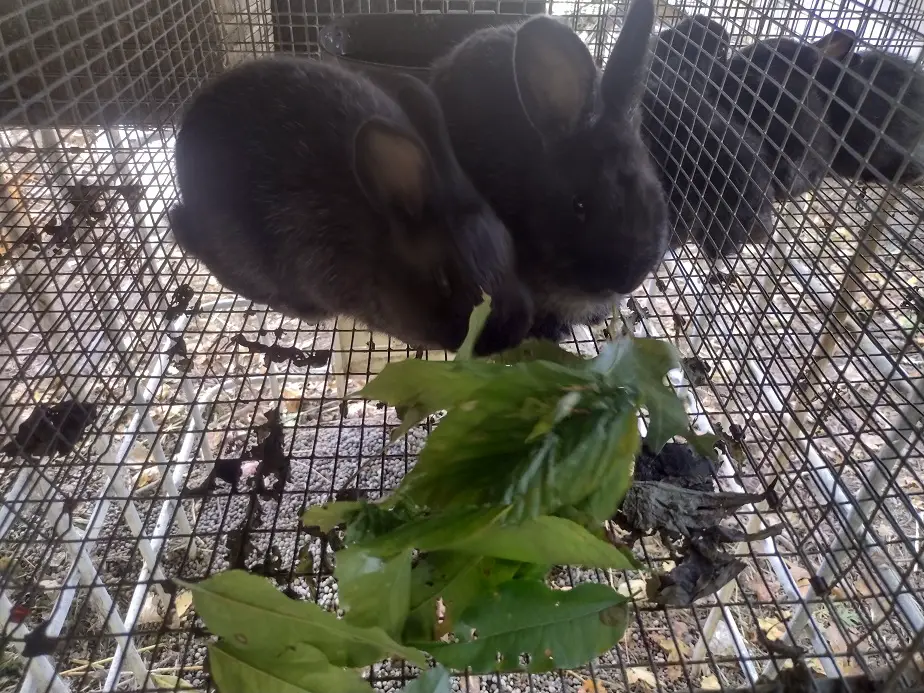
Meat Rabbit Feed Consumption for a Year
Here’s what we got going on
- 4 litters a year, 100 pounds feed per litter, 400 pounds of feed per year
- Does eat up to an additional 50 pounds per year in-between litters
- Bucks eat about 100 pounds feed a year.
Grand total of 550 pounds of feed a year for a single breeding pair of rabbits and 4 litters of bunnies raised to a butcher age of 12 weeks. (will vary based on your methods, schedule, and system)
Adding in that additional feed, that brings the total feed up by 37% for a single breeding pair. Since one buck can service up to 10 does, more animals become more efficient with feed. Still figuring 4 litters per doe per year, let’s see annual feed consumption with more breeders.
| does | bucks | litters/year | bunnies/year | # meat/year | # feed/year | # feed per # of meat |
| 1 | 1 | 4 | 32 | 80 | 550 | 6.8:1 |
| 2 | 1 | 8 | 64 | 160 | 1,000 | 6.2:1 |
| 3 | 1 | 12 | 96 | 240 | 1,450 | 6.0:1 |
| 4 | 1 | 16 | 128 | 320 | 1,900 | 5.9:1 |
| 5 | 1 | 20 | 160 | 400 | 2,350 | 5.8:1 |
| 6 | 1 | 24 | 192 | 480 | 2,800 | 5.8:1 |
| 7 | 1 | 28 | 224 | 560 | 3,250 | 5.8:1 |
| 8 | 1 | 36 | 256 | 640 | 3,700 | 5.7:1 |
| 9 | 1 | 40 | 288 | 720 | 4,150 | 5.7:1 |
| 10 | 1 | 44 | 320 | 800 | 4,600 | 5.7:1 |
Those are some pricey figures. If you want to raise rabbits as a cheap source of meat, that’s not the way to do it. Feeding commercially prepared feed is easy because it contains all the nutrition that rabbits need, but it’s costly.
You can expect to pay $25-$50 per adult rabbit to get started. As far as housing expenses, I can’t really pt much of an average number on that. I have built cages from pallets and used, rusty chicken wire for no cost. Some people pay hundreds to build a large, fancy cage setup.
A basic 30-dollar wire cage from a pet store will work for a doe and her young litter. You will need a separate cage for the buck, and one for the bunnies once they’ve been weaned. I really like an all-wire cage because they stay cleaner.
Just be sure your rabbits are contained and protected from the elements. You will need a nesting box for the does. You can make one, or buy one. Mine are 7 inches tall, 10 inches wide, and 16 inches long. 3 days before the due date, fill the nest with straw, wood shavings, or dried leaves and put it in the cage.
Rabbits have a gestation period of 32 days, plus or minus. If you breed on a Tuesday, they will usually have the bunnies on a Friday.
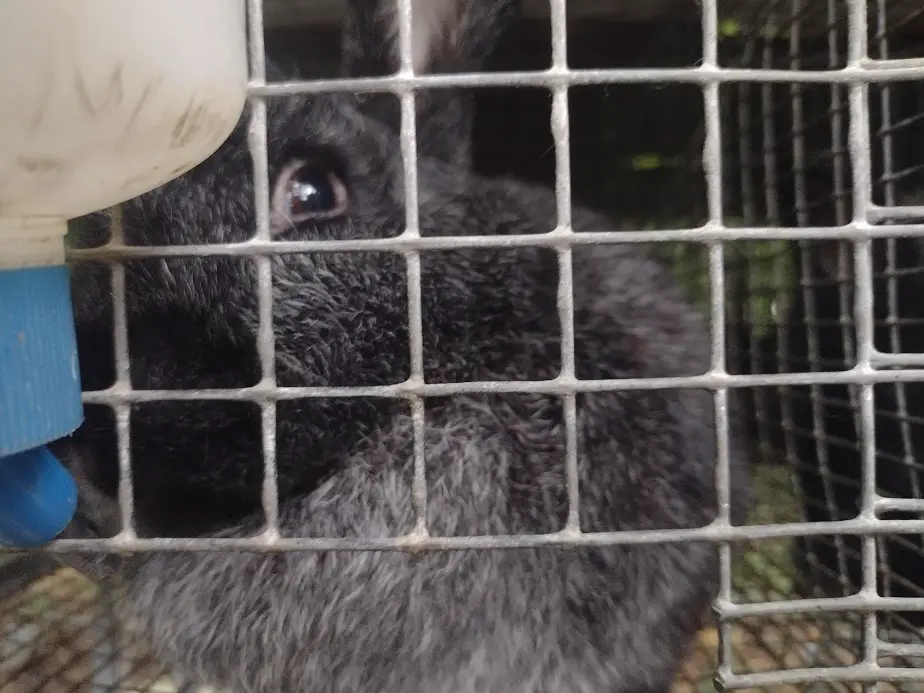
Best Feed for Meat Rabbits
Here’s a table put together of results we have had with various types of feeding programs.
| Feed type | Live weight | Carcass size | Age | Meat per litter |
| only grass | 1 lb. 10 oz | 13 oz | 12 weeks | 6-1/2 lbs. |
| *random browse mix | 2 lbs. | 1 lb. | 12 weeks | 8 lbs. |
| mostly grass, some clover | 2 lbs. 6 oz | 1 lbs. 2 oz | 12 weeks | 9 lbs. |
| Alfalfa hay (50-50 grass alfalfa) | 3 lbs. | 1 lb. 8 oz | 12 weeks | 12 lbs. |
| Mostly clover, some grass | 3 lbs 7 oz | 1 lb. 13 0z | 12 weeks | 14-1/2 lbs. |
| Mostly chickory, some grass | 3 lbs. 5 oz | 1 lb. 13 oz | 12 weeks | 14-1/2 lbs. |
| Mostly high-protein tree leaves, some grass | 4 lbs. | 2 lbs | 12 weeks | 16 lbs. |
| Mosty burdock leaves, some grass | 4 lbs. | 2 lbs | 12 weeks | 16 lbs. |
| cheap, local brand pellets (16 percent protein) | 5 lbs | 2 lbs. 9 oz | 12 weeks | 20-1/2 lbs. |
I’m personally not a fan of feeding an expensive pellet like Purina or Mana Pro. I see very little difference in the performance of feeding high-end pellets and a budget option. I prefer to feed more of a wild greens diet, even though the animals grow smaller. Feeding wild fodder saves a lot of money.
Most good fodder rations will grow a 3-4 pound rabbit with half that in meat. They may yield as little as half as much meat compared to rabbits fed pellets, but I can offset that by just having more breeding does. I want about 150 pounds of rabbit meat a year, which means 4 does would do it instead of two.
With all our animals, I figure on having more than we will likely need to hit our meat yield goals. Usually, that means I have plenty to sell or give away, but in a bad year, I’ll still have enough to feed my family. I do the same with the garden. Make it bigger than we should need in case it’s a bad year.
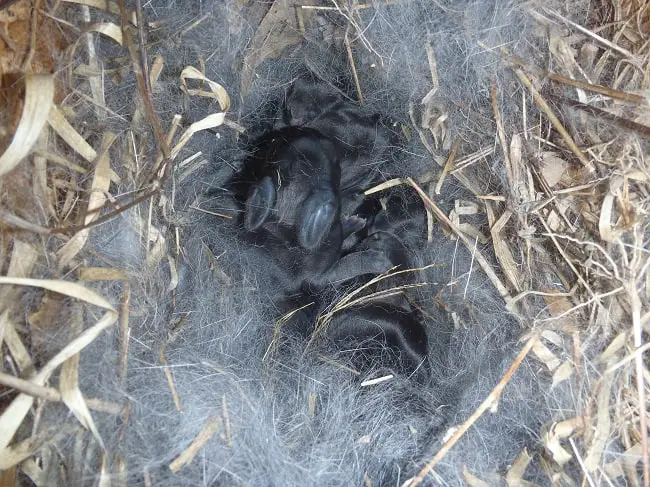
How Many Times can Rabbits be Bred in a Year?
Does can breed and birth 3 to 4 times a year. If you wean at 6 weeks and give the doe a week to recover, you can get 4 litters a year. If you give the doe a month to recover, she can get 3 breedings a year. Some breeders wean at 4 weeks to allow them 5 breedings a year to maximize meat production.
Weaning begins naturally around 4 weeks and by 5 weeks old, bunnies are eating mostly rabbit food. By 6 weeks, rabbits are pretty much completely done nursing. to wean them, just start separating them daily. separate two on the first day, then the rest over the week. that way the doe is more eased off nursing.
I find it important to give the doe a rest in-between breedings. A week is the minimum. If the doe is looking quite thin still after the week, She might get another few weeks. Sometimes they need a bit more time to get their weight back up.
Good Breeds of Meat Rabbit
- Holland Lop– Live weight, 2 pounds at 10 weeks, 1 pound carcass
- Florida White– Live weight, 2 pounds at 10 weeks. 1-pound carcass
- Rex– live weight, 4 pounds at 10 weeks. 2-pound carcass
- Californian– live weight, 4 pounds at 10 weeks. 2-pound carcass
- Silver Fox– Live weight, 4.5 pounds at 10 weeks. 2.5-pound carcass
- Satin– Live weight, 4.5 pounds at 10 weeks. 2.5-pound carcass
- New Zeeland– Live weight, 5 pounds at 10 weeks. 3-pound carcass
- Giant Chinchilla– Live weight, 6 pounds at 10 weeks. 3.5-pound carcass
These are some of the more popular rabbits raised for meat. Except for the holland op, they are all commercial breed rabbits. Commercial breeds are expected to gain weight quickly, have a high meat-to-bone ratio, and be efficient with feed.
The first rabbits we had were the Holland Lop. We bred them for meat and they were fair. Smaller for sure, but tasty.
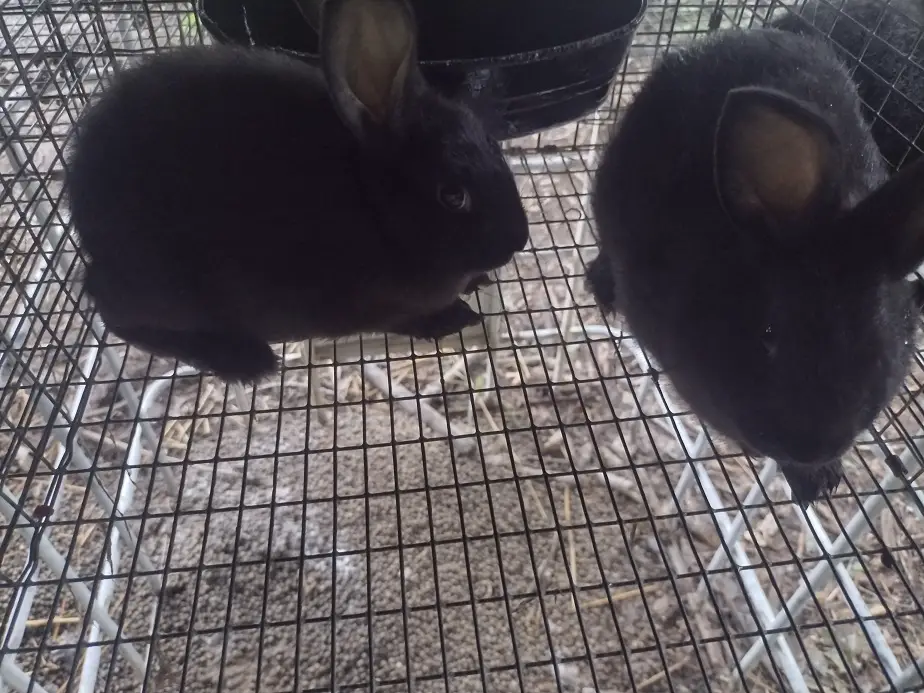
When to Butcher a Rabbit?
Rabbits are usually butchered between 8 and 12 weeks, but some people butcher at 14 or 16 weeks for larger carcasses. Younger rabbits are more efficient with feed and butchering after 12 weeks uses significantly more feed. Most commercial rabbitries butcher at 8 or 10 weeks.
A rabbit is most efficient with its feed the day it’s born. after that, every day means a little less efficiency. Bigger animals require more feed to simply maintain themselves, plus eating extra to gain weight. If fed pellets, I won’t ever let a rabbit go over 12 weeks.
This coming year, we’re focusing on butchering at 8-10 weeks to improve efficiency and see what difference it makes. Currently, we’re buying feed as well as feeding grasses and whole oats to stretch things. I need my dollars to be efficient.
Related Articles:

